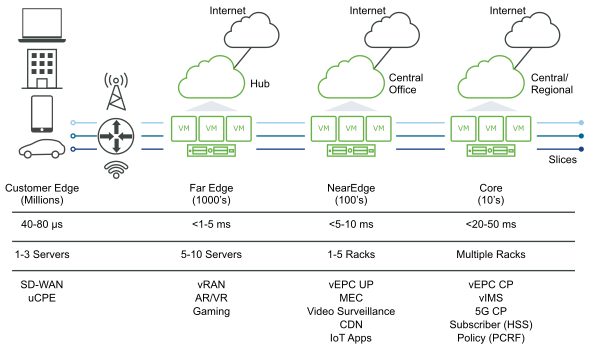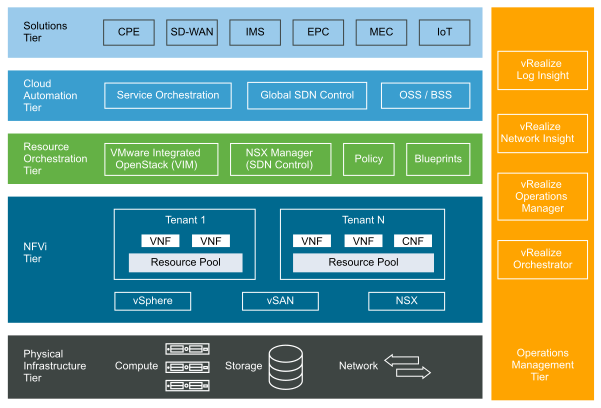5G services require a mixture of low-latency, high throughput, and high user densities and concurrences. The distribution of functional components will require a more sophisticated service delivery model.
The network is transforming into a mixture of highly distributed functions together with centralized functions. This way, the network is moving away from the typical centralized models in service delivery. There is also an emerging paradigm shift with employing third-party IaaS, PaaS, and SaaS offerings from public cloud providers.

The highly distributed topology of the network will support the next-generation service characteristics in distribution and composition. It will also require a new way of managing the network and infrastructure resources. The number of the services that are spanning the industry verticals is exploding exponentially. Today’s endpoint ranging in fixed and mobile offers will grow into the billions with IoT connections. The highly distributed edge sites are projected to be in the tens of thousands, regional sites in the 100’s, core sites in the 10’s, and a large variety of public cloud provider sites.
NFV and Software Defined Networking (SDN) transformations will introduce complex interconnections and interactions between end-points such as branches, small offices, connected cars, and IoT gateways to private data centers and public cloud providers. By definition, this environment and its transformation are not only a technical challenge but also impacts the business and operating processes.
Reference Environment Requirements
The reference environment places strict requirements for service placement and management to achieve optimal performance.
-
Federation options: The reference environment topology offers a diverse set of federation options for end-points, private and public clouds, each with distinct ownership and management domains. Virtualized end-points provide a better control and manageability, however they are not suitable for all types of use cases. Likewise, service functions can be distributed and managed across private and public clouds.
-
Disaggregated functions: Services are highly disaggregated so that control, data, and management planes can be deployed across the distributed topology, commonly referred to as CUPS. Edge clouds offer the performance advantages of low latency and data plane intensive workloads. Control and management plane components can be centralized with a regional and global scope.
-
Functional isolation: Provides network and service isolation across different tenancy models in the reference environment. However, resource management considerations need to be made for shared network functions such as DNS, policy, authentication, and so on.
-
Service placement: The highly distributed topology allows for flexibility in the workload placement. Making decisions based on proximity, locality, latency, analytical intelligence, and other EPA criteria are critical to enable an intent-based placement model.
-
Workload lifecycle management: Each cloud is elastic with workload mobility and how applications are deployed, executed, and scaled. An integrated operations management solution can enable an efficient lifecycle management to ensure service delivery and QoS.
-
Carrier grade characteristics: Because CSPs deliver services that are often regulated by local governments, carrier grade aspects of these services, such as high availability and deterministic performance are also important.
-
NFVI lifecycle (patching and upgrades): The platform must be patched and upgraded by using optimized change management approaches for zero to minimal downtime.
NFV Reference Model
NFV is an architectural framework that is first developed by the ETSI NFV Industry Specification Group. The framework provides a reference model where network functions are delivered through software virtualization with commercial off-the-shelf (COTS) hardware. This way, NFV moves away from the proprietary, purpose-built hardware that is dedicated to a single service. The result is a network that is agile, resilient, and equipped to deliver high quality services. The NFV framework defines functional abstractions and interactions between the building blocks. Some of these abstractions are already present in current deployments, while others must be added to support the virtualization process and operation.
The following diagram shows the reference model for an NFV environment with clear functional abstractions and interactions in a tiered approach.

- Physical Tier
-
Represents compute hardware, storage, and physical networking as the underlying pool of shared resources. In addition, there are numerous other physical network devices such as switches, routers, EMS, and so on, making the execution ecosystem a hybrid virtual and physical topology.
- NFVI Tier
-
The lowest tier of the vCloud NFV OpenStack Edition platform. It delivers the virtualization run-time environment with network functions and resource isolation for VM-based workloads. In NFVI, virtualized compute, storage, and networking are delivered as an integrated solution through vSphere, vSAN, and NSX-T Data Center. Isolated resources and networks can be assigned to a tenant slice, which is a runtime isolated partition delivering services. Tenant slices can be dedicated to a tenant or shared across tenants. The NFVI is optimized and adjusted for telco-class workloads to enable the delivery of quality and resilient services. Infrastructure high availability, performance, and scale considerations are built into this tier for performance optimization.
- Resource Orchestration Tier
-
It provides resource management capabilities to the NFVI tier. This way, the NFVI can deliver a flexible infrastructure-as-code for lifecycle management of workloads, network management, and resource management. The resource orchestration tier is responsible for controlling, managing, and monitoring the NFVI compute, storage, and network hardware, the software for the virtualization layer, and the virtualized resources. The VIM module manages the allocation and release of virtual resources, and the association of virtual to physical resources, including resource optimization. VIM also maintains the inventory of NFVI, including the linkage and relationship between components as they relate to an instance of a VNF or CNF workload. This way, VIM allows for monitoring in the context of a single VNF.
- Cloud Automation Tier
-
The service management and control functions which bridge the virtual resource orchestration and physical functions to deliver services and service chains. It is typically a centralized control and management function, including embedded automation and optimization capabilities.
- Solutions Tier
-
The multi-domain ecosystem of virtualized functions as a native VM. Such functions are composed in complex solutions to enable service offers and business models that CSP customers consume. Solutions can range from small branch office functions to a fully evolved packet core that is delivered as tenant slices across multiple clouds.
- Operations Management Tier
-
An integrated operational intelligence for infrastructure day 0, 1, and 2 operations that spans across all other tiers. The functional components within the operations management tier provide topology discovery, health monitoring, alerting, issue isolation, and closed-loop automation.